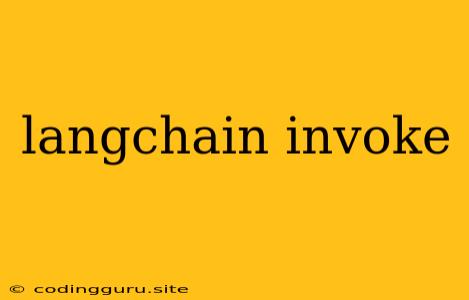Unlocking the Power of LangChain: A Guide to Effective invoke
LangChain is a powerful library that simplifies the process of building applications that leverage large language models (LLMs). One of its key features is the invoke method, a versatile tool for interacting with and controlling LLMs. But how exactly does invoke work, and what are its advantages? Let's dive in.
What is invoke in LangChain?
In essence, invoke is a function that allows you to execute an LLM with specific parameters. This function is used to send prompts and instructions to an LLM, receive its response, and then use that response in your application. It acts as the bridge between your code and the language model.
The Power of Parameterization
One of the key strengths of invoke lies in its ability to accept parameters. These parameters allow you to tailor the behavior of the LLM by:
- Specifying the prompt: You can use
invoketo send a custom prompt to the LLM, directing its response to a specific task or query. - Defining constraints: Parameters can help constrain the LLM's response, such as setting a maximum length, formatting requirements, or even restricting the output to a specific domain.
- Controlling the model: You can use parameters to select different models, adjust temperature (a measure of creativity), or modify other settings to influence the LLM's output.
Beyond Basic Prompts: The invoke Advantage
The invoke function shines when you need to do more than just ask a simple question. Here are some scenarios where invoke truly excels:
- Chain operations:
invokecan be used within a chain of LLM calls, allowing you to take the output of one LLM and use it as input for another. This opens up possibilities for complex workflows. - Dynamic prompts:
invokecan be used to generate prompts dynamically, allowing you to adapt the LLM's behavior based on user input or other real-time data. - Fine-grained control: The
invokefunction gives you fine-grained control over the LLM's execution, allowing you to optimize its performance for your specific use case.
Example: Using invoke for Text Summarization
Let's consider a simple example of using invoke for text summarization. In this scenario, we want to summarize a news article using an LLM:
from langchain.llms import OpenAI
from langchain.chains import load_chain
# Load the OpenAI model
llm = OpenAI(temperature=0.7)
# Load the summarization chain
chain = load_chain("summarize")
# Define the article content
article = "The world is changing rapidly, and technology is at the forefront. Artificial intelligence is rapidly transforming industries, from healthcare to finance."
# Use `invoke` to execute the chain
summary = chain.invoke({"text": article})
# Print the summary
print(summary)
In this example, we first load the OpenAI LLM and a summarization chain. Then, we provide the article text and use invoke to execute the chain. The chain.invoke call automatically sends the text to the LLM and returns the summary, demonstrating the ease and flexibility of invoke.
Conclusion
The invoke method is a powerful tool in LangChain's arsenal, allowing you to interact with LLMs in a flexible and controlled manner. From simple prompts to complex chain operations, invoke provides the means to build intelligent and sophisticated applications that leverage the potential of large language models.
